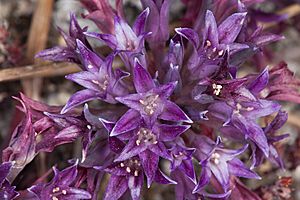Abrams' onion facts for kids
Quick facts for kids Abrams' onion |
|
|---|---|
 |
|
| Scientific classification | |
| Synonyms | |
|
Allium fimbriatum var. abramsii Ownbey & Aase ex Traub |
Allium abramsii is a special type of wild onion plant. It is also known as Abrams' onion. This unique plant grows only in a specific part of California, in the Sierra Nevada mountains. It's a small plant, but its pretty pink or purple flowers make it stand out.
Contents
What is Abrams' Onion?
Allium abramsii grows from a bulb, which is like a small underground storage part, similar to a regular onion. These bulbs are about one centimeter wide. The plant also has a thick rhizome, which is an underground stem that helps it spread. This wild onion can grow up to about 15 centimeters tall. It usually has one long, curving leaf that looks like a cylinder. At the top of the stem, you'll find a cluster of flowers. This cluster is called an inflorescence. It can have up to 40 flowers! Each flower is pink or purplish. They have special leaf-like parts called tepals, which are shaped like small spears. The flowers also have yellow anthers, which are parts that hold pollen.
Why is it Called Abrams' Onion?
The name abramsii was given to this plant to honor a person named LeRoy Abrams. He was an important botanist, someone who studies plants.
Where Does Abrams' Onion Grow?
Allium abramsii is endemic to a specific area. This means it grows naturally only in one place in the world. For this plant, that place is the central Sierra Nevada mountains in California. It likes to grow in coniferous forests. These are forests with trees like pines and firs. It prefers sandy soils made from granite. You can find this plant in Fresno, Madera, and Tulare Counties. It grows at elevations between 1,400 and 2,000 meters (about 4,600 to 6,500 feet) above sea level.
See also
 In Spanish: Allium abramsii para niños
In Spanish: Allium abramsii para niños

